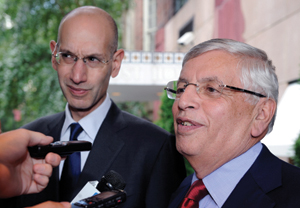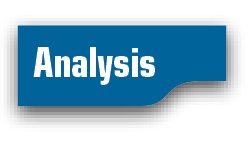NBA Commissioner David Stern emerged from last week’s first collective-bargaining session in a month with a message: We’re going to keep talking.
For many observers who have seen the gap remain wide between labor and management, that’s about as positive a tone as could have been hoped for.
Since the lockout was declared on July 1, there have been a total of two negotiating sessions. There hasn’t been as much public verbal jousting as there was in the NFL talks, nor the social media debates that took place on the football side. But there also hasn’t been a dedicated negotiating schedule and the sides remain far apart.
It shouldn’t come as any surprise, then, that as the clock continues to tick, the possibility of an uninterrupted season grows increasingly remote. Stern said after last week’s bargaining session that there is enough time to negotiate a new deal to keep the regular season intact, but that it would take warp-speed labor negotiations to avoid lost games.
Consider the recent NFL labor deal as a point of comparison. Talks began to seriously take shape after the league and the union held secret meetings in Chicago in early June, but even after those productive covert sessions, it still took the NFL two months of regular meetings to come to a deal just before training camps opened. That time frame certainly doesn’t bode well for the NBA, even after last week’s negotiations, though more talks are planned.
“When both parties are ready to make a deal, it can happen in 48 to 72 hours after they call the lawyers in, but, unfortunately, neither side is ready to make major concessions, and I’d be very surprised if the league doesn’t miss games,” said former NBA Deputy Commissioner Russ Granik, who is now vice chairman for Galatioto Sports Partners. “During the 1998 [NBA lockout] there was the sense that somehow it would work out and that the league would never go that far. Nobody will be surprised this time around.”
 |
AP IMAGES
David Stern, with Deputy Commissioner Adam Silver, says a complete season is still possible. |
Even if both the NBA and the National Basketball Players Association start holding productive meetings the week of Sept. 12, and are able to expedite negotiations into a rapid six weeks, that could still bring a late October date for any new CBA deal.
Factor in teams holding training camp, and the cancellation of at least the first few weeks of the NBA season looms as a definite possibility.
“The [NBA] needs H.G. Wells and his time machine to make the progress that they need,” said Andy Dolich, former NBA team executive with the Golden State Warriors and Memphis Grizzlies. “If you look at the history of most labor negotiations, it is when they go quiet when things really get done.”
The new NFL labor deal came from negotiations with a profitable league that was figuring how to split billions of dollars in revenue among its teams and players. In the NBA, the negotiations center on how to forge a new deal after a season when the league said it lost $300 million, with 22 of the 30 teams losing money.
“Three years ago, it became very apparent … that the NBA’s losses were enormous,” said one former NBA team executive who also was part of the NBA’s 1998-99 lockout. “The difference this year compared to 1998 is the need for fundamental economic change. When you have teams in the league that lose less money by not playing, it makes for a difficult negotiation.”
The NBA is pushing for drastic financial givebacks that would affect superstars and veteran players with salary cuts, a hard cap and non-guaranteed contracts.
“Star NBA players are at risk, unlike in the NFL, where [the new CBA] took enough hide out of the rookies with a wage scale,” said Mark Levinstein, a sports labor attorney and partner at Williams & Connolly in Washington, D.C. “There is no sense of urgency to get a deal done, and nobody seems to have an issue if games are missed early in the season. Not starting a season until January is not a killer.”
A look back at the 1998-99 NBA lockout that resulted in a truncated 50-game season provides a prospective cancellation timeline for the coming season. In 1998, the NBA announced on Sept. 24 the postponement of training camps. In mid-October, the league began canceling regular-season games. Then, in December, the NBA announced that it would cancel its All-Star Game, which was set for mid-February in Philadelphia. This year’s All-Star Game is scheduled for Feb. 26 in Orlando. The NBA and the players union finally signed a new deal on Jan. 20, 1999, to save the shortened NBA season.
“As you get closer to training camp, by the end of September is when things start to intensify and you get pressure by your respective constituents,” said the former NBA team executive. “If you cancel the preseason, then you don’t meet for a few weeks because you want the impact to set in.”
And it’s not the NFL labor deal that league experts like Granik said mirrors the NBA. Instead, it’s the NHL’s decision to shutter its 2004-05 season after failing to negotiate a new CBA that more closely mirrors the NBA’s current labor impasse.
In 2004, the NHL canceled its preseason two weeks out, then canceled its regular season in mid-February, 2005.
Granik points to that and the 1998-99 NBA lockout as examples that bring only less urgency on both sides to get a deal done prior to the start of the NBA season on Nov. 1.
“I am concerned that the lesson learned in the 1998-99 lockout is that even in January you can still save a season,” he said. “But when you get to the first week in October, that’s when you will lose games, which means everyone loses money.”





